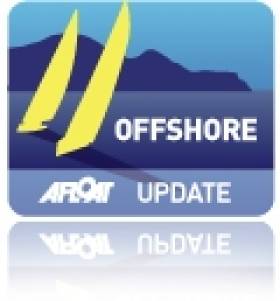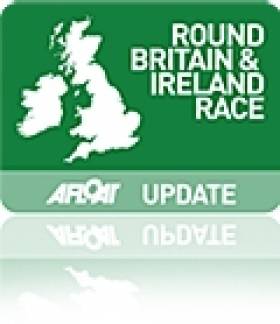Displaying items by tag: ICAP Leopard
Middle Sea Race Starts on Saturday
Flying into Malta it's hard not to be struck by the landscape: the buildings all a blinding beige in the hot sun, the landscape fairly arid and dry. It's more reminiscent of the Northern African coast, which is only 155 nautical miles west. The island archipelago is at the crossroads of the Mediterranean situated, as it is, midway between Sicily and the coast of Tunisia. This year's fleet reflects that more than any year past, with numerous entries from throughout Europe, Russia, the United Kingdom and the United States.
One Irish boat, Legally Brunette, from Dun Laoghaire is entered in to the race.
This 31st edition of the 606-nautical mile Rolex Middle Sea Race begins this Saturday, 23 October from Grand Harbour. Registration closes on Friday, but by press time there were 83 boats entered from 18 countries. Included in this number and back to defend, are 2009 Overall Winner, Andres Soriano on the 21-metre mini-maxi Alegre (GBR), and Line Honours winner, Mike Slade on the 30.5-metre ICAP Leopard (GBR).
The race is organized and hosted by the Royal Malta Yacht Club, which moved into stylish brand new quarters overlooking Marsamxett Harbour, just prior to last year's race. The yacht club, with as rich and varied a history as this island republic, is one of the most hospitable anywhere and provides all sailors who make the effort to trek here, a warm welcome.
Yesterday, a low pressure system that swept through south of Sicily, with winds of 50 knots and 3 to 4 metre seas, which has delayed the arrival of some of the foreign fleet. Though some like Esimit Europa 2 (SLO) and Wild Joe (HUN) were already committed to crossing and so endured the conditions encountered enroute. The 30-metre Esimit had a lightening strike that took out the wind instruments at the top of its 44-metre mast. Meanwhile, Marton Jozsa's Wild Joe, a R/P Custom 60, which set out from Croatia on Friday, and then from Sicily yesterday morning, had a tough crossing, ripping both their mainsail and jib.
Many of the fleet is moored in Camper & Nicholson's Grand Harbour Marina and dockside there today there was a flurry of activity with crews effecting repairs or otherwise prepping for Saturday's offshore race. Tomorrow, Wednesday, there will be Coastal Race most likely around neighboring Comino Island. Some boats, though not all, use this race as a tune-up for the offshore.
Along the quay, there were country flags on the back of boats from Spain, Italy, Hungary, Slovenia, the UK and United States, as well as a local fleet of competitors from Malta. One would think the Maltese might have an edge – local knowledge of the area, perhaps – and in that group one of the ringers may well be Jaru (MLT), a J/133 co-skippered by John Ripard Jr. and his brother-in-law, Andrew Calascione. The close relations don't stop there, as half the crew are composed of their children, with a few close friends from the UK there to round out the crew.
Sailing onboard, as helmsman and watch leader, is 23-year old, Sebastian Ripard. This youngest of the Ripard generation is taking time out from his, and team mate Benji Borg's, campaign in the 49er class for the 2012/2016 Olympics. This 600+ mile race requires switching gears from 'around the cans'. Asked what he likes about this, his eighth, race, Sebastian said, "It's a beautiful race. I mean one of the marks is a volcano, which is often erupting! There's always a bit of everything in this race, tactically there are a lot of different points where the race compresses, so there's a lot of tricky areas: the Straits (of Messina), Stromboli, by Favignana, which make it challenging throughout. There are a lot of variables that keep on changing. And I quite enjoy the mental demands of an offshore race; it's more of an adventure. In his first go round in 2002, he racked up an overall win on the J/109 Jammin' (MLT) with – same as this year – his father and uncle. He followed that with a 2nd place in the J/109 Artie (MLT) with Lee Sartariano.
The J-Boat has a good track record for the race: a J/133 won its' class and placed 2nd overall in the 2008 Rolex Middle Sea Race. The 43-footer was Sailing World magazines' "Boat of the Year" award when it was launched in 2003 and the design has proven itself for performance cruising and offshore racing.
Almost all foreign competitors seem drawn to this unique race: a long offshore, anti-clockwise around Sicily, a few volcanoes, and some neighboring islands. Bryon Ehrhart owner and skipper of Lucky (USA), is one of those. Ehrhart, from Chicago, first raced the boat in the 2006 Newport Bermuda Race. Since then they have competed in the 2007 Transpac Race, the 2008 Chicago Mackinac, and the 2009 Rolex Fastnet Race.
His crew are a group of strong amateurs, with a few professionals that have sailed together for years. For the most part, they are Etchells (one-design) sailors, and plan to bring that level of intensity and competitiveness from the small boat fleet to a big boat offshore program.
Ehrhart said, "We have an interest in doing the truly great ocean races and certainly the Rolex Middle Sea Race is one of them. It's a race that I have read about over the years and have thought that – because of the course – would be strategically and tactically challenging, maybe even the most challenging we have done or will ever do.
"A fantastic amount of preparation has gone into getting the boat ready for this race and we hope we are up to all that we may encounter. We have converted this TP52 to an IRC offshore boat. We do a couple of big events a year and this race is the only offshore event we are doing in 2010: it is a race of the quality that is worth organizing our year around. "
Thursday is a Crew Party at the Royal Malta Yacht Club, and on Friday there will be Skipper's race and weather briefing. The Rolex Middle Sea Race commences on Saturday, 23 October 2010. The final prize giving is on Saturday, 30 October. George David's Rambler (USA) established the current Course Record of 47 hours, 55 minutes, and 3 seconds in 2007.
Leopard Seeks Round Britain and Ireland Record
ICAP Leopard's crew will be made up of the usual collection of established ocean racers, including leading solo round the world sailor Sam Davies, who currently holds the monohull course record of six days, 11 hours, 30 minutes and 53 seconds. Sam broke the course record with fellow round the world sailor Dee Caffari aboard the IMOCA 60 Aviva in 2009. This year sees a highly competitive fleet, including Telefonica Azu's VO70 and the IMOCA 60 Artemis Ocean Racing, meaning the crew will need to push the boat hard to ensure line honours.
Mike Slade, commented: "Once again we have a great team onboard for this classic offshore race. Sailing around Britain and Ireland produces some of the most complex weather systems in the northern hemisphere, so we'll have to be on our toes to ensure we give ourselves a chance at beating the record."
Sam Davies, revered round the world sailor, said: "As current course record holder and having sailed the Sevenstar Round Britain and Ireland Race a number of times before, I cannot wait to get started. The nature of sailing around an island means that the weather systems are not consistent in direction and therefore produce very changeable weather. This makes it all the more challenging and one of the most interesting offshore races around."
Starting on the Royal Yacht Squadron line in the Solent, ICAP Leopard will head out of the Solent and along the South Coast, past Bishop Rock before heading north into the Celtic Sea. Leaving Ireland to starboard, the journey will then see the boat begin a 230 mile open water leg past St Kilda and the Flannan Isles. Through changeable and challenging weather conditions, the boat will continue around the Outer Hebridies, past Muckle Flugga and then down the East of the Britain. Having dodged the busy shipping lanes and oil rigs in the North Sea, the crew will undertake a final push past Dover finishing at the Royal Yacht Squadron line.
http://www.leopard3.com and follow the link to the Round Great Britain & Ireland Race pages.
ICAP Leopard Begins Transatlantic Record Attempt
Round Ireland race record holder ICAP Leopard, the 100ft super-maxi racing yacht owned by Mike Slade, crossed the start line at Ambrose Light on Saturday to begin her attempt on the 2,925 nautical mile monohull transatlantic speed record. ICAP Leopard will need to cross the finish line at Lizard Point before 12h 37m UTC on Saturday 5th June to break the current record held by Mari Cha IV of 6 days, 17 hours and 52 minutes.
Starting in 15 knots of wind, ICAP Leopard will head north to hook into a weather system developing over Nova Scotia this weekend. It is hoped that ICAP Leopard will be able to ride this weather system all the way across, however she may encounter some high pressure on the approach to the UK. It is hoped a fast start will give ICAP Leopard a good chance of getting through the high pressure and across the line in record time.
ICAP Leopard will be carrying a GPS tracker during her record attempt, to follow her progress online go to: www.leopard3.com































































